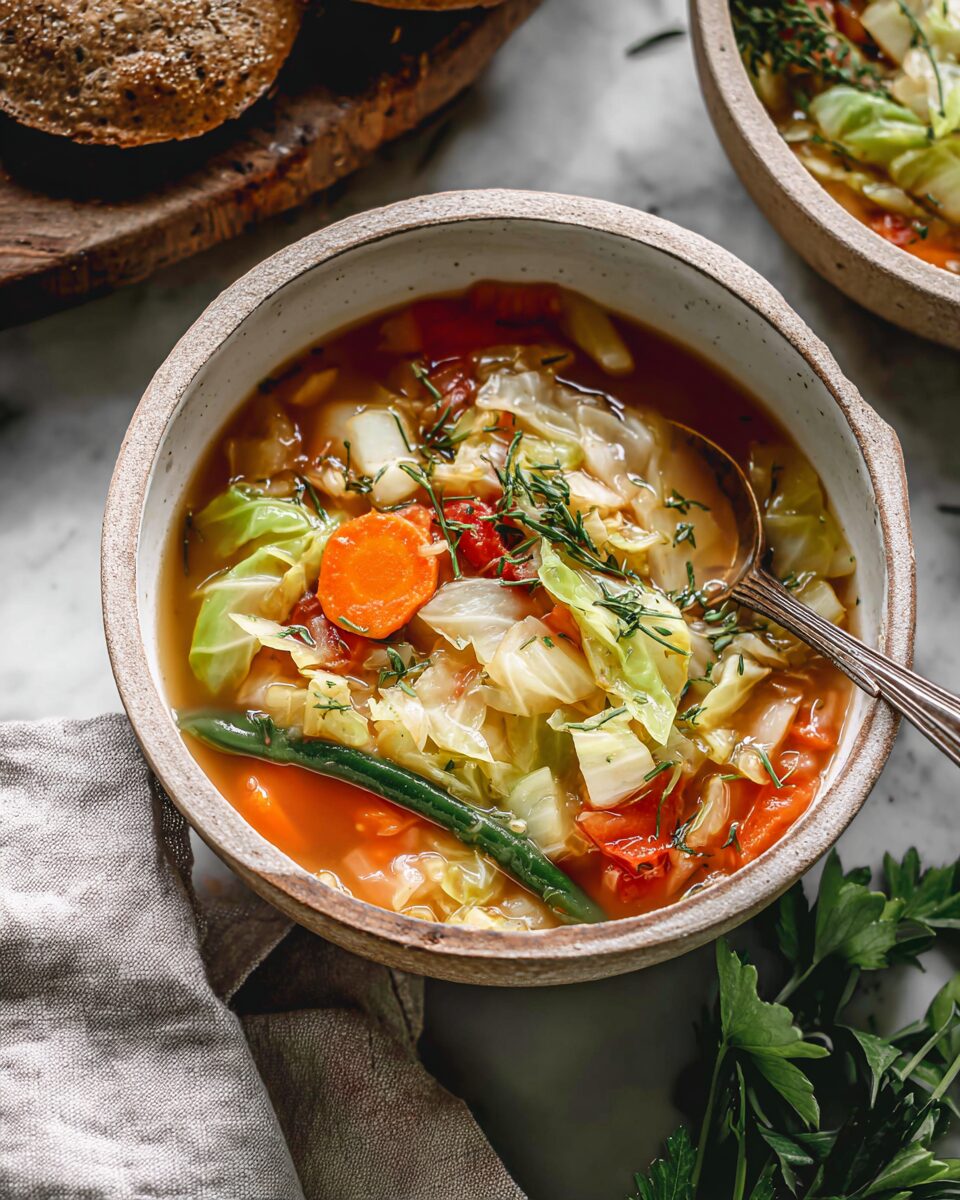The perfect blend of clean eating and cozy comfort, this Cabbage Detox Soup is your go-to bowl when you want something healthy, hearty, and incredibly flavorful. With just a few simple ingredients like cabbage, carrots, green beans, and zucchini, it’s light on calories but big on nutrition. This soup supports your goals whether you’re meal prepping for the week, doing a reset, or just craving something warm and wholesome.
What sets this soup apart is its versatility and ease. You can customize it with whatever veggies you have on hand, and it stores beautifully for quick meals throughout the week. Best of all, it’s made in just one pot — minimal cleanup, maximum flavor. Perfect as a light dinner, a weight-loss aid, or a satisfying start to a plant-based lifestyle, this soup truly does it all.
Full Recipe:
-
3 cups nonfat low-sodium beef broth (or vegetable/chicken broth)
-
2 cloves garlic, minced
-
1 tablespoon tomato paste
-
2 cups chopped cabbage
-
½ yellow onion, chopped
-
1 cup chopped carrots
-
1 cup green beans, trimmed and cut
-
½ cup chopped zucchini
-
1 cup diced tomatoes
-
1 tablespoon fresh basil, chopped
-
½ teaspoon dried oregano
-
Kosher salt and freshly ground black pepper to taste
-
Olive oil spray
Directions:
-
Spray a large pot with olive oil spray and heat over medium-high.
-
Sauté the onions, carrots, and garlic for about 5 minutes until softened and aromatic.
-
Add the broth, tomato paste, diced tomatoes, chopped cabbage, green beans, basil, oregano, salt, and pepper. Stir to combine.
-
Reduce heat to a simmer and cook for 10 minutes, allowing the vegetables to soften.
-
Stir in zucchini and continue simmering for an additional 10 minutes.
-
Taste and adjust seasoning if needed. Serve hot, garnished with chopped chives or thyme if desired.
Prep Time: 10 minutes | Cooking Time: 20 minutes | Total Time: 30 minutes
Kcal: 42 kcal | Servings: 6 bowls
Recipe Overview
Cabbage soup is one of those timeless, comforting dishes that manages to be both incredibly simple and surprisingly flavorful. Often dubbed a “miracle soup” in diet culture circles, this vegetable-forward dish has become a favorite for anyone looking to eat light without sacrificing taste. Packed with fiber-rich cabbage, fresh vegetables, and fragrant herbs simmered in a savory broth, cabbage soup is warm, satisfying, and nourishing on every level.
History and Origin
The history of cabbage soup is as layered as the vegetable itself. Cabbage has been cultivated for thousands of years and holds culinary significance in numerous cultures around the world. From Europe to Asia, it has long been appreciated for its durability, affordability, and nutritional value. While it’s difficult to pin down one definitive origin of cabbage soup, versions of it have appeared throughout history as part of peasant cuisines—simple meals made from accessible, nutrient-dense ingredients.
In Eastern Europe, cabbage soup is a staple. The Russian “shchi,” Polish “kapuśniak,” and Romanian “ciorbă de varză” are all variations of cabbage-based broths that have been passed down through generations. These soups were often served hot during harsh winters and were prized for their ability to feed large families on minimal ingredients. In Asian cuisine, Chinese and Korean soups often feature napa cabbage and may include elements like tofu or kimchi, creating deeper layers of umami.
In the West, cabbage soup took on new fame during the late 20th century when it became associated with diet trends. The infamous “Cabbage Soup Diet” gained popularity in the 1980s and 1990s as a rapid weight-loss method. While the diet itself was controversial, the soup remained beloved for its low calorie count and satisfying flavor. Today, cabbage soup enjoys a more balanced reputation as a healthy, delicious, and comforting meal, divorced from fad diet culture and embraced for its versatility and heartiness.
Variations and Adaptations
Cabbage soup is one of those beautiful dishes that welcomes improvisation. Depending on your pantry, seasonal produce, or cultural background, you can tweak this recipe in countless ways.
In Mediterranean-style adaptations, olive oil, tomatoes, oregano, and basil take center stage, giving the soup a fresh, herbaceous character. You might add chickpeas or cannellini beans for a plant-based protein boost.
In Eastern European households, a more robust version of cabbage soup might include smoked meats like kielbasa or ham hocks, imparting a smoky depth that turns the humble bowl into a hearty stew. Potatoes and sauerkraut are also common additions, contributing a tangy twist.
Asian-inspired versions may feature napa cabbage, ginger, garlic, scallions, and a splash of soy sauce or sesame oil. Tofu or thinly sliced beef can be added for protein, transforming the soup into a more substantial meal.
For spice lovers, Southwestern versions of cabbage soup might include chili powder, cumin, jalapeños, or chipotle peppers. These additions give the soup a warm, bold profile perfect for cooler weather.
And then, of course, there’s the classic diet-friendly version: low in calories, brimming with cabbage, carrots, celery, and green beans, and flavored with simple herbs and tomato paste. It’s easy to make in large batches, which is why it remains a go-to for meal preppers and those looking to maintain a balanced lifestyle.
Nutritional Information
Cabbage soup is an impressive nutritional powerhouse despite its simplicity. One serving typically clocks in at under 50 calories, making it ideal for those watching their intake or looking for a light but satisfying option.
Macronutrients:
-
Calories: ~42 per serving
-
Protein: 2–3g
-
Carbohydrates: 8g
-
Fat: <1g
Micronutrients:
-
Vitamin C: Cabbage and tomatoes are excellent sources, providing immune-boosting and skin-supporting benefits.
-
Vitamin A: Carrots contribute a substantial dose of beta-carotene, which supports vision and immune health.
-
Potassium: Important for heart and muscle function, found in carrots, zucchini, and tomatoes.
-
Folate & Fiber: Cabbage is rich in both, supporting digestive health and cellular repair.
Because it’s naturally low in fat and sugar, cabbage soup is suitable for a wide range of diets: vegan, gluten-free, Whole30 (with some adjustments), and low-carb (if you skip or reduce starchy vegetables). It’s also hydrating, thanks to its broth base, which makes it a smart choice when you’re under the weather or recovering from illness.
Serving Suggestions and Pairings
While cabbage soup can certainly stand alone, it also shines when paired with complementary sides and additions. Here are a few ideas to take your cabbage soup meal to the next level:
-
Crusty Bread or Whole Grain Rolls: A slice of sourdough or a warm whole-grain roll adds satisfying texture and depth.
-
Grilled Cheese or Vegan Cheese Toasties: If you’re looking to indulge a bit, this classic pairing adds richness to balance the soup’s light broth.
-
Simple Side Salads: A mixed greens salad with a citrus vinaigrette brightens the dish and adds freshness.
-
Protein Additions: To transform the soup into a heartier meal, consider stirring in shredded rotisserie chicken, a soft-boiled egg, or sautéed tofu cubes.
-
Lemon Wedges & Fresh Herbs: A squeeze of lemon and a sprinkle of fresh parsley, dill, or thyme can elevate the flavor and presentation instantly.
-
Drink Pairings: Try pairing with a crisp white wine like Sauvignon Blanc, a kombucha, or even a light herbal tea like chamomile or peppermint.
Whether you’re enjoying it for lunch or a light dinner, cabbage soup is versatile enough to accompany almost any component of your meal plan.
Tips and Tricks for Success
If you’re new to cooking with cabbage, here are some insider tips to help your soup come out perfect every time:
-
Use a mix of broths for deeper flavor—try combining beef and vegetable broths, or add a touch of mushroom broth for umami.
-
Don’t overcook the cabbage. It should be tender but still have a slight bite. Overcooked cabbage can become mushy and overly sulfurous.
-
Layer your vegetables—sautéing the aromatics like onions, garlic, and carrots first helps build flavor.
-
Spice to taste—this soup is forgiving. Feel free to adjust herbs and spices based on your personal preference.
-
Make it ahead. Cabbage soup often tastes even better the next day as the flavors continue to meld.
-
Freeze in individual portions. This makes for quick meals on busy days. Just reheat on the stovetop or in the microwave.
Potential Health Benefits
Cabbage soup isn’t just a feel-good meal; it can also play a supportive role in your overall wellness.
-
Digestive Health: The high fiber content helps regulate digestion and support a healthy gut microbiome.
-
Detox Support: Its hydrating nature, coupled with detoxifying vegetables like cabbage and zucchini, makes it a favorite in detox and cleanse routines.
-
Anti-inflammatory Properties: Ingredients like garlic, carrots, and tomatoes contain antioxidants and compounds that help combat inflammation.
-
Heart Health: Low in fat and high in potassium, cabbage soup may contribute to lower blood pressure and better cardiovascular function.
-
Weight Management: Low-calorie and nutrient-dense, it supports satiety without contributing to calorie overload—ideal for those pursuing weight loss goals.
Plus, the warm broth is soothing, making it a go-to comfort food when you’re feeling under the weather.
Conclusion
Cabbage soup is proof that wholesome, delicious meals don’t need to be complicated or expensive. It’s a recipe rich in tradition, adaptable to modern lifestyles, and versatile enough to suit just about any dietary need. Whether you’re prepping a week’s worth of healthy meals, cooking on a budget, or simply craving a bowl of warmth and goodness, this classic soup delivers every time.
So go ahead—grab that head of cabbage, open your spice drawer, and let your pot simmer with love. You’ll be surprised how such a humble dish can become such a staple in your kitchen.





